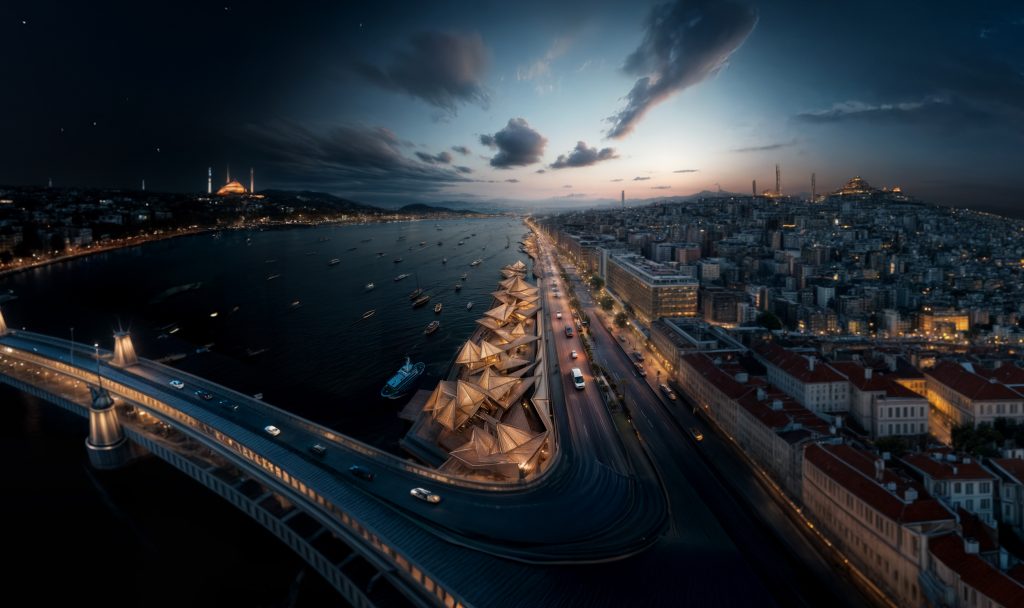Fold Me a Path: Farah Swilam’s Visionary Ferry Terminal Redefines Istanbul’s Golden Horn
A New Language for Public Infrastructure Emerges from Human–AI Collaboration
In the ever-evolving landscape of architectural innovation, few projects manage to tread the delicate line between radical experimentation and deeply humanist design. “Fold Me a Path: An Experience of Fractured Flow” is one such project—a bold, research-driven proposal for a prefabricated ferry terminal on Istanbul’s storied waterfront, conceived by Farah Swilam, a RIBA Part II Architectural Assistant and recipient of the distinction-level Master’s from Oxford Brookes University. Swilam, who brings the rigor of a dual background in Architecture and Construction (earned in Alexandria, Egypt) and a keen research interest in computational design and digital fabrication, offers a masterclass in redefining how architecture can be both by and for people.
Blurring the Boundaries: AI as Co-Designer
At the heart of “Fold Me a Path” lies a methodological provocation: what happens when artificial intelligence is not a mere tool, but a creative partner? Swilam’s approach began with iterative AI prompting—feeding digital and physical prototypes into generative algorithms and extracting unexpected spatial forms guided by both computational logic and human interpretive agency. Rather than settling for parametric repetition, the process leverages the latent logic of movement studies, the mathematical clarity of crystallography, and the geometric lyricism of Islamic patterns. The result: a vocabulary of shifting, fragmented geometries that echo the flows and rhythms of the Golden Horn.
AI’s influence is evident not just in the forms themselves, but in the choreography of user experience throughout the terminal. Swilam’s project challenges assumptions about authorship, exploring the tension between suggestion and decision—ultimately proposing an architecture that is neither wholly controlled nor entirely random, but co-authored.
A Symphony of Modular Fragments
Physically, the terminal unfolds as a fractured promenade—a procession of interlocking, prefabricated units that glide along the waterfront piers. Each module subtly adjusts its direction, transparency, and height in response to site context and programmatic demands. The organization draws explicit parallels to crystallographic modularity, with each fragment both distinct and essential to the collective whole.
Prefabrication and modular assembly emerge not as aesthetic afterthoughts, but as structuring principles. The terminal’s main shell is fabricated using CNC-milled timber, its sweep and flow accentuated by a patchwork of brass cladding panels that shimmer in Istanbul’s shifting light. This system is both lightweight and robust, designed for phased deployment directly onto piers—thus preserving valuable urban land for the public realm while animating the waterfront with a dynamic architectural presence.
Architecture as Journey: Three Levels of Experience
Swilam’s spatial concept unfolds across three experiential strata. On the ground level, users are ushered along a clear circulation path, punctuated by crisp thresholds and generous openings—inviting the city inward while framing views out onto the Golden Horn. The mid-level introduces a finer grain of interaction: angular partitions and calibrated apertures filter the sunlight, creating zones of pause and encounter, while directing the gaze towards the water and the city beyond. The highest strata—raised, layered canopies and transparent enclosures—elevate the journey, providing both shelter and revelation.
Each level is meticulously tuned to amplify human behavior and perception, sustaining a choreography through light, shadow, and spatial rhythm. This careful calibration reflects Swilam’s sensitivity to both social context and spatial narrative—a hallmark of her teaching practice as well, both on-campus in Alexandria and through her international workshops on Rhino, Grasshopper, and AI-driven design.
Material Innovation and Fabrication Intelligence
“Fold Me a Path” is not an exercise in digital formalism; its speculative beauty is matched by rigorous constructability. Swilam’s expertise in digital fabrication, honed through her work with 3D-printed bioplastics and mathematically driven timber structures, is evident at every stage. Advanced modeling tools inform the milling of timber shells, while integrated infrastructure—ducting, insulation, and assembly hardware—underscore a commitment to performance and sustainability.
Brass cladding panels, subtly contoured, reinforce the visual rhythm along the waterfront while withstanding the rigors of the marine environment. The project thus stands as an exemplar of how contemporary fabrication can enable expressive yet pragmatic responses to infrastructural needs.
Redefining Authorship and Adaptability in Civic Design
One of the project’s most significant provocations is its proposed shift in authorship. In a profession often defined by singular visions, Swilam’s use of AI as a design collaborator invites a plural, adaptive approach to spatial systems. The terminal’s form emerges through continual dialogue—between human intuition and algorithmic suggestion—proposing a model for future infrastructure that is as responsive as it is visionary.
Moreover, by deploying on water rather than land, the project reframes how cities can grow their public amenities: adaptively, incrementally, and without sacrificing precious terrestrial space. This adaptability, coupled with advanced prefabrication, makes “Fold Me a Path” a template not only for Istanbul, but for waterfront cities worldwide.
Connect with Farah Swilam
Farah Swilam’s trajectory embodies a new generation of architects—those who bridge computational prowess with humanist values, and who see digital tools as partners rather than mere instruments. She is currently seeking new opportunities in London or for remote, computational design-driven roles, poised to bring her unique expertise in AI, fabrication, and spatial innovation to the next wave of architectural practice.
To explore potential collaborations or to learn more about her work, connect with Farah on LinkedIn, follow her on Instagram @acciofxra7_, or reach out via email at farahswilam19@gmail.com. Farah represents not just the future of architectural practice, but its imaginative present—where code and craft converge, and infrastructure becomes an art of experience.







Add a comment